What is Bluefin Tuna Hon-Maguro ?
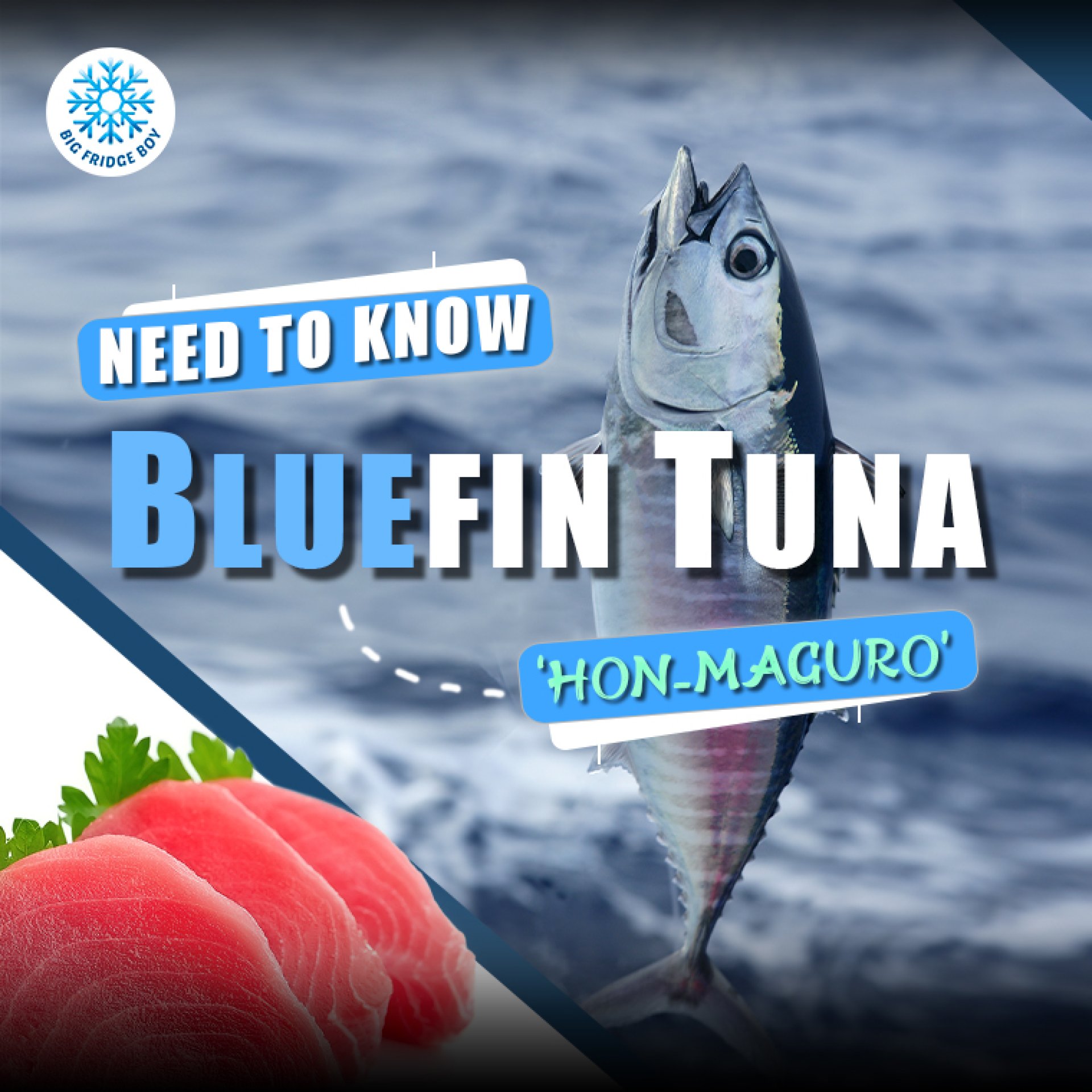
Bluefin Tuna also known as “Hon-Maguro” is a highly prized and sought-after fish species that is renowned for its rich, buttery flavor and tender texture. It is a warm-blooded, pelagic fish that is found in temperate and tropical waters throughout the world, and it is known for its long-distance migrations and high-quality meat. Bluefin Tuna is a highly valued ingredient in cuisine around the world, particularly in Japanese cuisine where it is used in sushi and sashimi dishes. Here is everything you need to know about Bluefin tuna.
Bluefin tuna (Thunnus thynnus) is a species of tuna that can be found in the Atlantic and Pacific Oceans. They are one of the largest species of tuna and can grow up to 15 feet (4.6 meters) in length and weigh more than 1,500 pounds (680 kg). Bluefin tuna has a deep, rich flavor and is considered one of the most prized fish in the world.
There are three recognized species of Bluefin Tuna.
- Atlantic Bluefin Tuna (Thunnus Thynnus): This is the most well-known and largest species of Bluefin Tuna. It is found in the Atlantic Ocean, from Newfoundland to the Gulf of Mexico, and from Norway to the Mediterranean Sea.
- Pacific Bluefin Tuna (Thunnus Orientalis): This is a smaller species of Bluefin Tuna that is found in the Pacific Ocean, from Japan to California.
- Southern Bluefin Tuna (Thunnus Maccoyii): This is the smallest species of Bluefin Tuna, and it is found in the southern hemisphere, primarily off the coasts of Australia and New Zealand.
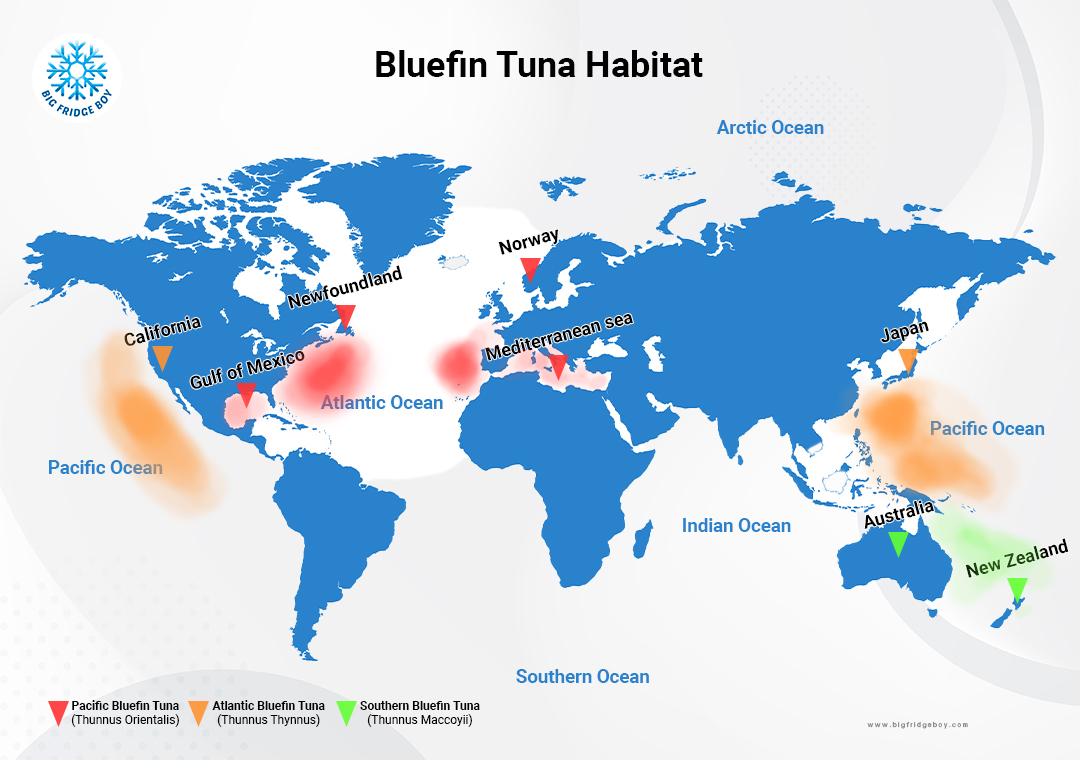
Habitat
Bluefin Tuna is a highly migratory fish that can be found in a variety of habitats throughout the world. It is a warm-blooded fish that prefers to live in temperate and tropical waters, and it is known for its long-distance migrations between different regions and spawning grounds.
- In the Atlantic Ocean, Bluefin Tuna is found primarily in the western and eastern regions, with populations in the Gulf of Mexico, the Mediterranean Sea, and the North Atlantic Ocean. The fish typically spawns in the Gulf of Mexico and the Mediterranean Sea, and it migrates to colder waters in the north during the summer months.
- In the Pacific Ocean, Bluefin Tuna is found primarily in the western and central regions, with populations in the waters of Japan, Korea, and Australia. The fish typically spawns in the western Pacific Ocean and migrates to the northern and eastern regions during the summer months.
- Bluefin Tuna is a pelagic fish that prefers to live in the open ocean, where it can swim freely in deep water. It is a highly migratory species that can travel thousands of miles in a single year, and it is capable of diving to depths of up to 1,500 feet (457 meters).
Overall, Bluefin Tuna is a highly adaptable fish that can thrive in a variety of habitats throughout the world. Its migratory habits and ability to travel long distances make it a fascinating and important species in the world of marine biology.
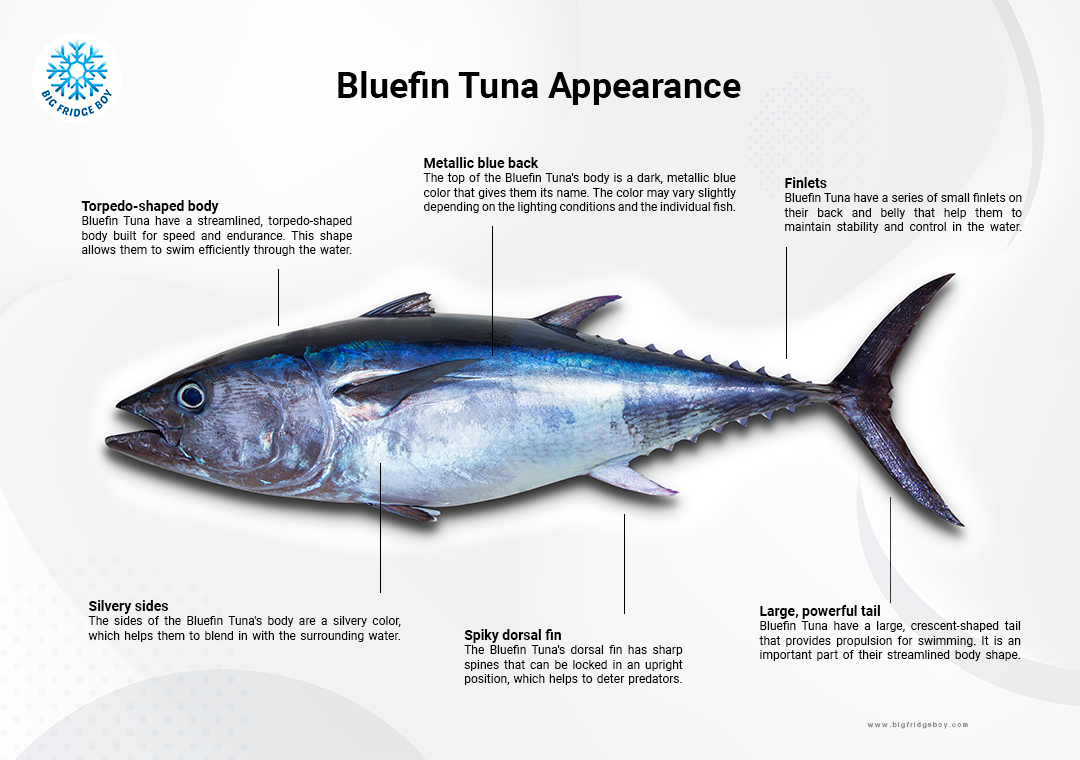
Appearance
Bluefin Tuna have a distinct appearance that sets them apart from other species of tuna. Here are some key features of their appearance:
- Size: The Atlantic bluefin tuna can grow up to 15 feet (4.6 meters) in length and weigh more than 1,500 pounds (680 kg), while the Pacific bluefin tuna can grow up to 9.8 feet (3 meters) and weigh around 990 pounds (450 kg).
- Torpedo-shaped body: Bluefin Tuna have a streamlined, torpedo-shaped body built for speed and endurance. This shape allows them to swim efficiently through the water.
- Metallic blue back: The top of the Bluefin Tuna's body is a dark, metallic blue color that gives them its name. The color may vary slightly depending on the lighting conditions and the individual fish.
- Silvery sides: The sides of the Bluefin Tuna's body are a silvery color, which helps them to blend in with the surrounding water.
- Large, powerful tail: Bluefin Tuna have a large, crescent-shaped tail that provides propulsion for swimming. It is an important part of their streamlined body shape.
- Finlets: Bluefin Tuna have a series of small finlets on their back and belly that help them to maintain stability and control in the water.
- Spiky dorsal fin: The Bluefin Tuna's dorsal fin has sharp spines that can be locked in an upright position, which helps to deter predators.
Overall, Bluefin Tuna have a distinctive appearance that reflects their unique adaptations for life in the open ocean. Their streamlined body shape, powerful tail, and metallic blue coloration make them a striking sight in the water.
Diet
Bluefin tuna are opportunistic feeders and will consume a variety of prey, including fish, squid, and crustaceans. They are active predators that use their speed and agility to catch prey in the open ocean.
Bluefin Tuna are also known to feed on other species of tuna, including Skipjack Tuna (Katsuwonus pelamis) and Yellowfin Tuna (Thunnus albacares), although they are not known to prey on other Bluefin Tuna.
The exact diet of Bluefin Tuna may vary depending on factors such as location, time of year, and availability of prey. However, they are generally known to be voracious predators that consume large amounts of food in order to support their high metabolism and active lifestyle.
Lifespan
Bluefin Tuna can live for several decades, although the exact lifespan of an individual fish can vary depending on a variety of factors. Here are some key points about the lifespan of Bluefin Tuna:
- Age at maturity: Bluefin Tuna is a slow-growing species, and they do not reach sexual maturity until they are several years old. The age at which they become mature varies depending on the population and the location, but it is generally around 5-10 years of age.
- Lifespan: Bluefin Tuna can live for up to 40 years or more, although many do not survive that long due to fishing pressure and other factors. The exact lifespan of an individual fish depends on factors such as genetics, diet, and environmental conditions.
- Size and age: Bluefin Tuna grow quickly when they are young, and they can reach several feet in length within their first few years of life. However, their growth slows as they age, and larger individuals are generally older.
Overall, Bluefin Tuna are a long-lived species that can survive for several decades if they are not impacted by fishing or other threats. The slow growth rate and late maturity of Bluefin Tuna make them particularly vulnerable to overfishing, as it can take many years for populations to recover from depletion.
Fishing methods
There are several methods used to fish for Bluefin Tuna, including both traditional and modern techniques. Here are some common methods used to catch Bluefin Tuna:
- Pole-and-line fishing: This is a traditional method of fishing that involves using a long pole with a hook and line to catch Bluefin Tuna one at a time. This method is often used in artisanal and small-scale fisheries, particularly in Japan.
- Purse seine fishing: This is a type of fishing that involves surrounding a school of Bluefin Tuna with a large net and then closing the net like a purse, trapping the fish inside. This method is often used in commercial fishing, particularly in the Mediterranean Sea.
- Harpoon fishing: This is a traditional method of fishing that involves using a long pole with a spear-like tip to catch Bluefin Tuna one at a time. This method is often used in artisanal and small-scale fisheries, particularly in the United States.
Peak season
Bluefin tuna can be enjoyed year-round, but the best season to eat it can vary depending on the region and the specific type of bluefin tuna. Generally, the highest quality bluefin tuna is caught during the colder months, as the fish tend to have a higher fat content, which contributes to the flavor and texture of the meat.
The quality of Atlantic bluefin tuna is considered at its best from November to February due to a combination of factors related to their biology, behavior, and environmental conditions.
- Fat content: During the colder months, Atlantic bluefin tuna tend to have a higher fat content. This fat, also known as "toro" in Japanese, is highly prized for its rich, buttery taste and smooth, melt-in-your-mouth texture. The increased fat content is a result of the tuna preparing for migration, building up energy reserves to fuel their long journey.
- Migration: Atlantic bluefin tuna are migratory fish, traveling long distances between feeding and spawning grounds. The colder months coincide with their migration patterns when they move from their feeding grounds in colder waters to their spawning grounds in warmer waters. Catching them during this time allows fishers to target the tuna when they are closer to the surface and have accumulated more fat.
- Seasonal availability: The winter months are when bluefin tuna are more concentrated in certain areas, making it easier for fishers to locate and catch them. For example, in the Mediterranean Sea, Atlantic bluefin tuna are more abundant during the winter months, as they prepare for their migration toward their spawning grounds.
- Taste and texture: The colder water temperatures can have a positive impact on the taste and texture of the bluefin tuna. The increased fat content helps to keep the flesh tender and moist, while the cold water can help to firm up the texture.
The quality of Pacific bluefin tuna is considered to be at its best from December to March due to several factors related to their biology, behavior, and environmental conditions, similar to Atlantic bluefin tuna.
- Fat content: Pacific bluefin tuna tend to accumulate more fat during the colder months, as they prepare for migration and spawning. This increased fat content, particularly in the prized belly portion known as "toro" in Japanese cuisine, results in a richer, more flavorful taste and a smoother, melt-in-your-mouth texture.
- Migration: Pacific bluefin tuna are migratory fish that travel long distances between feeding and spawning grounds. During the colder months, they migrate to different areas, often closer to the surface, as they move from their feeding grounds in colder waters to their spawning grounds in warmer waters. This makes it easier for fishers to catch them and coincides with the period when the tuna have built up energy reserves in the form of fat.
- Seasonal availability: The winter months are when Pacific bluefin tuna tend to be more concentrated in specific areas, making them easier to locate and catch. For example, the waters around Japan, particularly around the Tsushima Strait and the East China Sea, see an increase in Pacific bluefin tuna during the winter months.
- Taste and texture: As with the Atlantic bluefin tuna, the colder water temperatures can have a positive impact on the taste and texture of Pacific bluefin tuna. The increased fat content helps to keep the flesh tender and moist, while the cold water can help to firm up the texture.
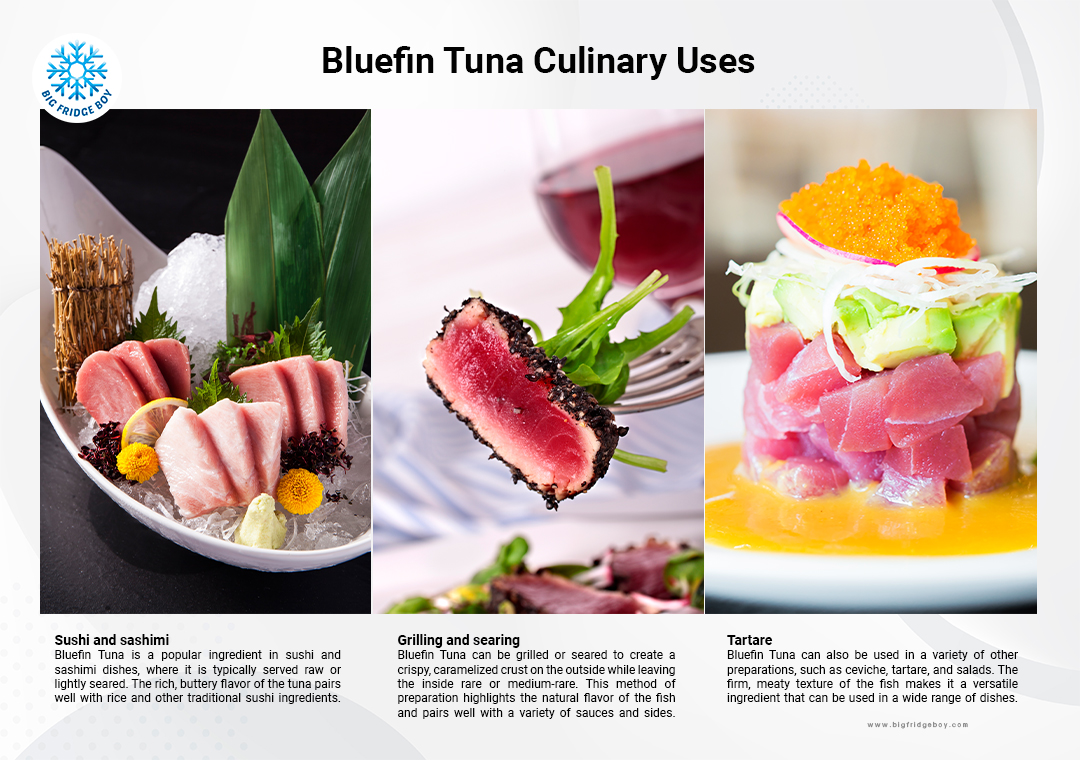
Culinary uses
Bluefin Tuna is a highly prized fish for its rich, flavorful meat, which is high in healthy omega-3 fatty acids. It is a versatile fish that can be prepared in a variety of ways, and it is particularly popular in Japanese cuisine. Here are some common culinary uses for Bluefin Tuna:
- Sushi and sashimi: Bluefin Tuna is a popular ingredient in sushi and sashimi dishes, where it is typically served raw or lightly seared. The rich, buttery flavor of the tuna pairs well with rice and other traditional sushi ingredients.
- Grilling and searing: Bluefin Tuna can be grilled or seared to create a crispy, caramelized crust on the outside while leaving the inside rare or medium-rare. This method of preparation highlights the natural flavor of the fish and pairs well with a variety of sauces and sides.
- Other preparations: Bluefin Tuna can also be used in a variety of other preparations, such as ceviche, tartare, and salads. The firm, meaty texture of the fish makes it a versatile ingredient that can be used in a wide range of dishes.
Overall, Bluefin Tuna is a popular ingredient in Japanese cuisine and can be prepared in a variety of ways to suit different tastes and culinary traditions.
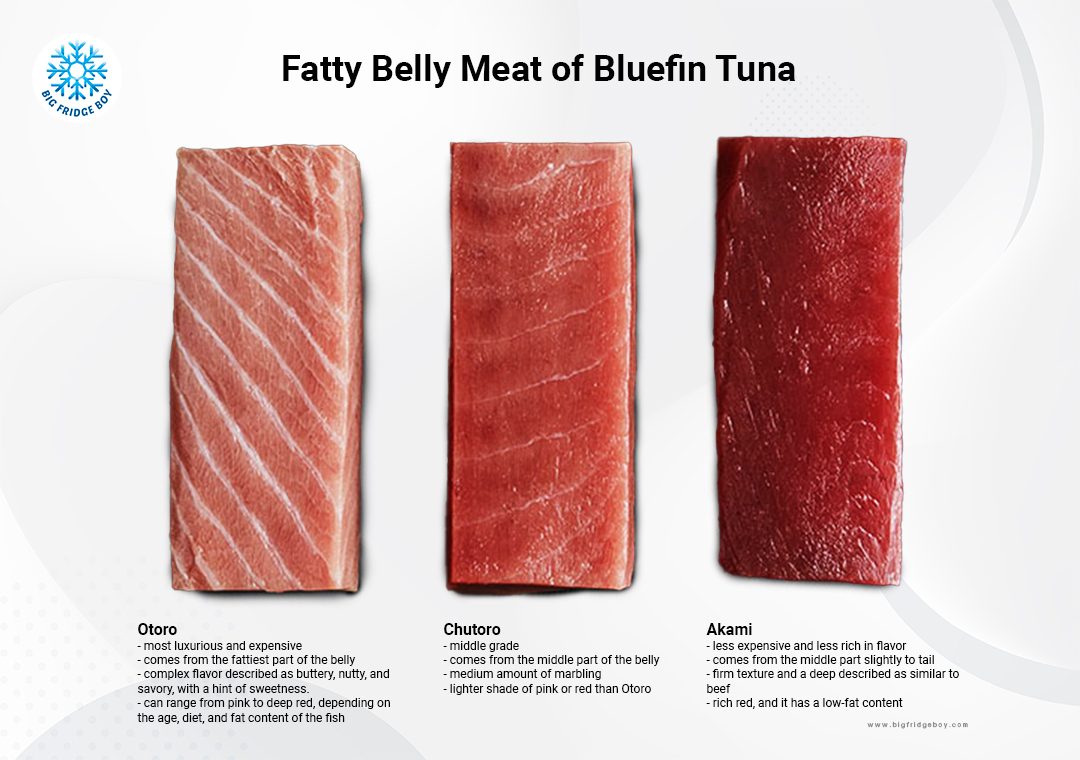
Most popular part
The most expensive and popular part of Bluefin Tuna is the fatty belly meat, which is known as toro in Japanese cuisine. This is because the belly meat of Bluefin Tuna has a high concentration of fat, which gives it a rich, buttery flavor and tender, melt-in-your-mouth texture. The quality and price of toro can vary depending on the fat content, color, and texture of the meat.
There are three main grades of toro, which are determined by the fat content and texture of the meat:
- Otoro: Otoro is the highest grade of toro, which is the fatty belly meat of Bluefin Tuna. It is considered to be the most luxurious and expensive part of the fish, prized for its rich, buttery flavor and tender, melt-in-your-mouth texture. Otoro comes from the fattiest part of the belly, closest to the head of the fish, and it has a high concentration of intramuscular fat, which gives it its distinctive flavor and texture.
Otoro has a soft, delicate texture that practically melts in your mouth. It has a deep, complex flavor that is often described as buttery, nutty, and savory, with a hint of sweetness. The color of Otoro can range from pink to deep red, depending on the age, diet, and fat content of the fish. The highest quality Otoro is considered to be the fattiest and most marbled, with a soft, velvety texture and a deep, rich flavor.
Otoro is a highly prized ingredient in Japanese cuisine, particularly sushi and sashimi dishes. It is often served raw or lightly seared, with minimal seasoning to allow the natural flavor of the fish to shine through. Due to the high demand and limited supply of Otoro, it is one of the most expensive and sought-after ingredients in the world of seafood.
- Chutoro: Chutoro is a grade of toro, which is the fatty belly meat of Bluefin Tuna. It is considered to be a middle grade between Otoro (the highest grade) and Akami (the leanest grade). Chutoro comes from the middle part of the belly, where the fat content is slightly lower than in Otoro but still higher than in Akami.
Chutoro has a firm, but tender texture and a rich, full flavor that is less intense than Otoro but more flavorful than Akami. The color of Chutoro is a lighter shade of pink or red than Otoro, and it has a medium amount of marbling, which gives it a creamy, buttery mouthfeel.
Chutoro is often used in sushi and sashimi dishes, where it is typically served raw or lightly seared. It is a popular choice among sushi chefs because it has a good balance of flavor and texture, making it versatile for a variety of preparations. Due to its high quality and delicious taste, Chutoro is still considered to be an expensive and luxurious ingredient.
In summary, Chutoro is a premium grade of Bluefin Tuna belly meat that has a firm, but tender texture and a rich, full flavor. While not as expensive or rare as Otoro, Chutoro is still a highly prized ingredient in Japanese cuisine and is valued for its quality and taste.
- Akami: Akami is a grade of Bluefin Tuna that refers to the leaner, meatier parts of the fish, specifically the loin section. It is the opposite of toro, which is the fattier belly meat of the fish. Akami is less expensive and less rich in flavor compared to toro, but it still has a meaty, savory taste that is prized in Japanese cuisine.
Akami has a firm texture and a deep, meaty flavor that is often described as similar to beef. The color of Akami is a deep, rich red, and it has a low-fat content, which gives it a more pronounced flavor compared to the milder toro and Chutoro. It is commonly used in sushi and sashimi dishes, where it is typically served raw or lightly seared.
While not as expensive or sought-after as toro, Akami is still a prized ingredient in Japanese cuisine and is often used as a more affordable alternative to the more luxurious cuts of Bluefin Tuna. The quality and price of Akami can vary depending on the age, size, and origin of the fish, as well as the time of year and the supply and demand of the market.
In summary, Akami is the leaner, meatier part of Bluefin Tuna that has a firm texture and a deep, meaty flavor. It is less expensive and less fatty than Toro, but it is still valued for its quality and taste in Japanese cuisine.
The price of Bluefin tuna can be influenced by several factors, including but not limited to.
- Quality: The quality of the tuna, including factors such as fat content, color, and texture, plays a significant role in determining its price. Tuna with higher fat content, particularly in the belly area (Otoro), is considered more desirable and can command higher prices.
- Size: Larger bluefin tuna tend to be more expensive because they often have higher fat content and are considered more desirable in terms of taste and texture. Additionally, larger fish require more time and effort to catch, which can also contribute to a higher price.
- Seasonality: The price of bluefin tuna can vary depending on the time of year. As previously mentioned, the best season for bluefin tuna is generally during the colder months when the fish have a higher fat content. During these months, demand for high-quality tuna is typically higher, which can drive up prices.
- Auction prices: In some cases, particularly at famous fish markets like Tokyo's Toyosu Market (formerly Tsukiji Market), bluefin tuna can fetch extraordinarily high prices at auction. These high-profile auctions can influence overall market prices, especially when a particularly large or high-quality fish is sold.
- Sustainability and certification: Sustainably sourced bluefin tuna can command higher prices due to increased consumer awareness and demand for responsibly harvested seafood. Certifications like the Marine Stewardship Council (MSC) label can add value to the product, as they ensure that the fish has been caught using sustainable practices.
- Transportation and handling: The cost of shipping and handling, especially for fresh bluefin tuna, can be significant. Proper storage, handling, and transportation are crucial to maintaining the quality of the fish, and these factors can contribute to the final price.
Bluefin tuna is one of the largest species of tuna. premium quality highest price because the meat is soft and melts delicious intense taste and high insertion fat pattern especially the part of Otoro which is in great demand in luxury restaurants. If you want to eat, it is recommended to be between November and February, which is the best because it is high in fat.







